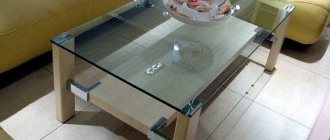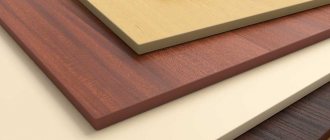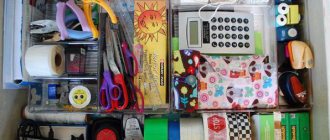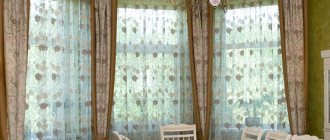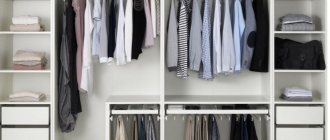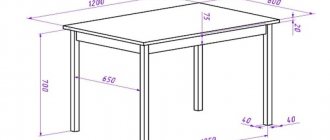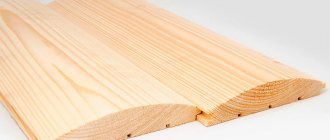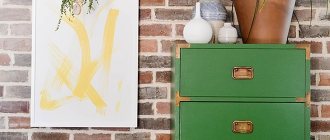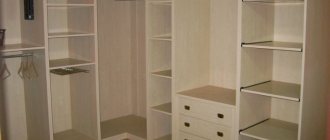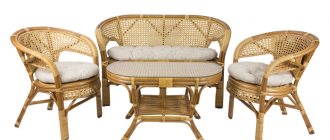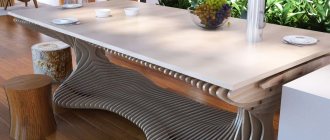General information about MDF
MDF is a material that has a wood structure.
MDF is a medium density pressed sheet with a wood fiber structure. They were first heard of in the United States of America in 1966. In Sweden, the technology was improved. Innovative developments in building materials came to Russia only in 1997. The first plant was opened in the village of Sheksna, Vologda Region. The board did not immediately gain popularity, but thanks to its advantages, it gradually began to replace the previously common chipboard.
Main features
The uniqueness of the pressed canvas is its similarity to natural wood and ease of manufacture. Panels are created from shavings, just like chipboard, but unlike the latter, the mass is highly crushed and heated.
As a result of this innovation, natural glue is released from the wood, which makes the material safe for health. A special production method gives the product strength, it does not crumble when drilled, and lends itself to any carpentry interventions (complex carving, sawing).
Decoding the abbreviation
MDF is the Russian equivalent of the American abbreviation. In English the name sounds like medium density fiberboard. Literally translated, it means medium-density fiber board.
MDF is a medium density fiberboard.
Properties
Thanks to innovative production technology, the fine particle board differs in its characteristics from its closest competitors: chipboard and fiberboard. Basic indicators:
- strength – withstands loads without traces of deformation, similar to wooden structures;
- moisture resistance – permissible operating conditions at air humidity up to 80%;
- biostability – not susceptible to mold, bacteria, fungi;
- environmental friendliness - non-toxic additives are used in production, the product is marked E1, safe for use in residential premises;
- uniformity - without defects;
- heat resistance – does not deform under the influence of temperature changes;
- insulating properties - does not allow sounds to pass through;
- manufacturability - lends itself to any tools, is easy to glue, paint or varnish.
Advantages
High performance characteristics give MDF sheets valuable properties:
- safe in the children's room, kitchen and bathroom;
- suitable for creating complex structures of non-standard shape;
- used on curved surfaces;
- do not require preliminary leveling before painting and decorating;
- suitable for floors, ceilings, walls;
- hold fittings and fasteners well;
- do not require special skills during installation;
- Easily interchangeable if damaged.
MDF sheets are safe in a child's room.
Among the advantages of pressed fiber boards are a low price compared to natural wood, a long service life and a large selection of decorative options.
Content
- What is it and scope of application
- Features and Benefits
- Features and sizes of MDF
- Forms and methods of material processing
- Varieties
- Laminated
- Veneered
- For painting
- Decorative wall panels
- Moisture-resistant panels
- Glossy canvases
- Flexible panels
- Kronospan
MDF is a medium density fiberboard. The abbreviation stands for Medium Density Fiberboard. This is a material that is quite in demand on the construction market and is used for the production of interior and decorative items. If your choice fell on MDF: what kind of material it is and where it is used, it will be useful to find out before you start using it.
Specifications
Physico-mechanical properties of wood fiber fabric:
- The density of the finished product is in the range of 600-980 kg/m3.
- Withstands mechanical stress during bending of 17-23 MPa, during tension - 0.50-0.65 MPa.
- Within 24 hours, it withstands swelling by 17% at a sheet thickness of 6-9 mm, and no more than 8% at 30-45 mm.
- The elastic modulus is 1700 mPa.
Compound
The main component of MDF is wood fibers, the content of which is 82%. Urea-formaldehyde resins act as a binder - 9%. Water accounts for 8% and 1% is paraffin, which gives water-repellent properties to the finished product.
Wood fibers are the main component of MDF.
Dimensions
In construction and furniture production, slabs of various sizes are used:
- thickness, mm – 3, 4, 6, 10, 16, 18, 24, 30;
- length and width – 2070x2800 mm, 1830x2440 mm, 2070x2620 mm.
At the same time, moisture-resistant panels have a standard size of 1220x2400 mm, and laminated sheets, embossed, perforated and imitating stone - 2070x2800 mm.
Permissible deviation in width and length is ± 5 mm, in thickness ± 0.2 mm. The deviation from the straightness of the edges should not be more than 0.2 cm.
Production technology
In the manufacture of MDF, both solid logs and waste from the woodworking industry are used.
- For the production of slabs, highly crushed sawdust is used, which is obtained by cutting pre-cleaned logs. The resulting fraction is cleaned of foreign inclusions, treated with hot steam and fed into the refiner.
- During the process, wood pulp releases a binding agent - lignin, which ensures good adhesion of the fibers. Depending on the quality of the source material, resins and paraffin are added to the mixture, and in some technologies a hardener is added.
- The resulting mass is sent for drying, where excess moisture is removed. Then a forming and pre-pressing process occurs, which removes air and creates a complete web.
- At the main stage, pressing, the thickness of the slab is adjusted to the required value, cut and left to cool.
- During the grinding process, the material acquires its final consumer appearance, unevenness and roughness are smoothed out, and if necessary, it is veneered, painted or laminated.
Sawdust is used to produce MDF.
MDF board production process
In fact, the composition of the MDF board is compressed residues from wood processing industry products. Therefore, the use of such slabs does not harm forestry.
The wood is ground into fibers and cleaned of various impurities such as sand. After this, the product is washed and dried. The finished mass is heated, and then formed into a solid tape of the required width and pressed. Wood residues are bonded under pressure using the natural substance lignin. The product takes on its final appearance at the finish, when the remaining air mass is squeezed out of the finished mass. After the molding process is completed, the material is sent for grinding, where the resulting flaws are removed and the MDF is given its final thickness.
It is worth remembering that not all types of wood can produce the required amount of lignin for bonding. In such cases, various additives are used during the production process. In some cases, it may be the same lignin, but just from a different type of wood.
It can be noted that MDF panels are considered the safest, since the binder is of natural origin. Also, during the production process, various special properties are given to the boards in order to expand the range of application of the material.
Species diversity
Due to the wide range of applications of MDF, manufacturers produce different types of sheets depending on the shape, production technology, finishing and installation method.
By shape
There are 3 types of products:
- Slatted - an elongated rectangular sheet. It is light in weight, with possible widths from 15 to 32.5 cm, lengths from 240 to 270 cm. The panels are used for wall cladding, so the product has a lock, on which the strength of the structure depends.
- Tile - small tiles of square or rectangular shape. Range of sizes from 30 to 98 cm. Used for wall decoration. Mounted on a frame or hidden fastening system.
- Sheet - large-sized canvas. Used by professionals for construction work or in furniture production.
By processing method
Depending on the manufacturing method, there are:
- solidly pressed - a polished board without a decorative coating, the surface is easy to paint, bends well, used to create furniture of any configuration, arches or when decorating uneven walls;
- decorative - the design has a special device for easy installation, used for cladding walls, less often floors or ceilings;
- moisture resistant - the composition includes substances that give the product special properties that allow the material to be used in rooms with high humidity, for example in bathrooms;
- Kronospan - sheets are distinguished by high density, have high performance characteristics, and are used for decorating floors.
MDF is distinguished by its manufacturing and processing method.
By finishing method
MDF differs in different types of front side finishing.
- Laminated. The surface is covered with a special film of melanin, paper-resin or PVC. It is used in interior decoration and in the creation of furniture, such as kitchen sets. Advantages: large assortment, the film provides additional protection from moisture and temperature exposure. With prolonged exposure to negative factors, it swells and moves away from the canvas.
- Veneered. A thin layer of wood is glued to the front side of the canvas, which gives the surface a natural look. A thin layer of stone chips or polyester resin can be used as veneer. The material resists the negative effects of moisture and temperature and is not afraid of mechanical damage. The service life is not inferior to furniture made of natural wood.
- Cork. The product is covered with a thin layer of cork. The cost of such a plate is high.
- Plastic. A thin layer of plastic is applied to the front side. The advantages of this treatment are the durability of the material, withstands high temperatures, and does not fade under the influence of ultraviolet rays.
- Enameled or acrylic. The base is coated with paint and then varnished. Large selection of colors and types - matte, glossy, glitter, pearlescent. Painted surfaces are resistant to detergents.
- Milled - a relief pattern on the front side is created by pressing, then covered with paint or laminated.
By installation method
Different types of slabs have different installation methods:
- Tile. It is laid in a geometric pattern on a flat wall surface using glue. To fix the panels together, additionally use clamps.
- Lining. The elements are connected using a lock (tongue and groove). Installation is simple and does not require special skills.
- Sheet. The surface is decorated with large canvases that have a holistic pattern. Mounted using decorative seams.
MDF tiles are laid on a flat surface.
Documenting
It makes no sense to register an individual entrepreneur for an MDF manufacturer, since the enterprise’s activities are initially focused on cooperation with legal entities. The priority form of doing business is LLC.
Basic OKVED code 16.21.12 “Production of particle boards from wood or other lignified materials.” However, for full-fledged work, you will need to collect your own package of codes, including in it, for example, OKVED 16.10 “Sawing and planing of wood”, OKVED 16.10.9 “Providing wood impregnation services”, etc. If you plan to sell goods through an online store or opening your own points of sale will also require the appropriate codes.
All MDF boards produced in the Russian Federation must comply with GOST 32274-2013 “Monostructural wood boards. Technical conditions". Laboratory testing is carried out on such parameters as moisture resistance, density, roughness, strength, swelling when exposed to moisture and many others.
In accordance with the legislation of the Russian Federation, confirmation of the conformity of MDF quality is carried out only in a voluntary certification system. In this case, the certificate will still have to be issued, since the vast majority of customers want to be sure of the safety and reliability of the products. In addition, you will need a certificate confirming the fire safety of the produced MDF. It is issued on a mandatory basis, for example, in the case of panels that are used to decorate emergency exits. Also, a fire safety certificate for MDF will be required to obtain certificates for finishing materials for interior spaces. You can obtain the document at the nearest certification center accredited by the Ministry of Emergency Situations.
Areas of use
The advantages of fibreboards are used in the production of furniture (tables, sets, sofas, etc.) and during construction work:
- decorating walls and ceilings;
- creating partitions;
- production of interior doors;
- decoration of ceilings;
- formation of the subfloor;
- roof sheathing, etc.
Facades
Kitchen facades made of MDF are popular in Russia and other countries. Thanks to different methods of processing the material, you can choose an individual decor:
- figured;
- bent;
- with convex elements;
- painted;
- with frames.
Kitchen facades made of MDF are popular in Russia.
Frame facades are complemented with inserts, which are used as glass, fabric, MDF with another type of coating.
Apron
To protect the wall in the kitchen from moisture, grease and temperature, you need a material that has:
- resistance to mechanical damage;
- moisture resistance;
- ease of installation;
- easy care.
MDF has all the necessary properties, at the same time it is low in cost and resistant to mold and mildew. There is a large selection of design solutions for the kitchen. When installing the panel, the ends should be covered with aluminum or plastic profiles. The stove must be protected from any mechanical damage.
Tabletop
This MDF element is an inexpensive way to create a beautiful and functional interior. Working with a knife should be carried out on a special board. A large selection of products allows you to make any style: high-tech, art deco, modern, etc.
A large selection of countertops allows you to create a beautiful interior.
Doors
More and more door manufacturers are choosing wood fiber sheets. The advantages include low weight, ease of manufacture (the material does not crumble), impact resistance, resistance to high humidity, does not deform from temperature changes, absorbs sounds, long service life, and a large selection of design options.
Ceiling
Suitable where there are large uneven areas or where communication lines need to be hidden. To attach the panels, a special frame is first installed, as for drywall.
Among the advantages of the canvas are good sound insulation, are not subject to rotting, ease of maintenance, and long service life.
Windowsill
An MDF window sill can be made of any color and texture, the surface can be matte or glossy. The material should be selected with a thickness of at least 22 mm. The negative side of the product is that it is afraid of mechanical damage.
An MDF window sill is afraid of mechanical damage.
Wall panels
Thanks to its simple installation, it has become popular to use pressed lining for wall decoration. In addition, manufacturers offer a large selection of panels to suit any interior.
In case of mechanical damage, you can easily replace the damaged element with a new one. MDF additionally insulates the room from noise and temperature changes.
Features and Benefits
Nowadays MDF can be seen in many interior and decor items; the boards are often used for finishing work. The high popularity is explained by the good performance properties and advantages of the material:
- The most important property and positive point is safety. When working with the stove and its operation, no harmful fumes are released into the air that can harm a person. The characteristics of MDF are close to natural wood.
- MDF boards are very plastic and lend themselves well to processing, cutting, and drilling. Objects of intricate shapes are made from this material, and in skillful hands they turn into a real work of art. True, furniture is made from MDF quite rarely; a combination of MDF and laminated chipboard is more common.
- The slabs can be used for finishing work in rooms with high humidity (up to 70%). The slabs are quite resistant to external influences, so they are often used in the kitchen, bathroom and toilet.
- Another property is fire resistance. Thanks to special impregnations, it is possible to improve this indicator, making the use of slabs as safe as possible.
- Due to their good density, the slabs can withstand heavy loads, so they can be laid on the floor and not worry about loss of symmetry of the pattern and breakage.
- Unlike many wood materials, MDF boards are not susceptible to fungi and microorganisms.
The advantages also include low cost, making the material accessible to a wide range of people.
Selection criteria: what to look for
The choice of fabric depends on the conditions in which it will be used: temperature, humidity, exposure to sunlight, the possibility of mechanical damage, loads.
For exterior decoration or bathrooms, moisture-resistant sheets should be considered - laminated sheets are good. When tiling interior spaces, pay attention to the sound insulation indicator - there is a large selection of colors and textures. An important feature of the environmental friendliness and safety of wood fiber boards for living rooms, especially for children’s rooms, is the formaldehyde emission class E-1.
To choose high-quality MDF, follow simple recommendations:
- buy building materials in large stores with a good reputation;
- read the quality certificate for the product;
- Carry out an external assessment of the canvas - check for chips, roughness, and uniform coloring.
The choice of fabric depends on temperature and humidity.
Another promising option
Anyone who has encountered construction knows that brick is an expensive material. Currently, there is a tendency for its price to rise due to the high energy consumption of production. Today there is a worthy alternative to this material. These are sawdust concrete blocks. They have excellent physical, chemical and environmental properties, which allows them to take their rightful place among the already traditional building materials.
Popular manufacturing companies
The reputation of a company engaged in the production of building boards is influenced by the quality of products, their range, compliance with international standards, compliance with environmental standards, and the use of innovative technologies. Popular companies include:
- Austrian company Egger. Offers more than 230 types of various decor, incl. stylization of natural marble and other rocks, as well as 12 shades of white.
- Swiss concern SWISS KRONO. It has production facilities in different countries, incl. Russia. The color range of design solutions has more than 170 types.
- Belgian company Spanolux. It produces slabs for various purposes and compositions (fire-resistant, moisture-resistant, lightweight, etc.). Cladding is carried out at the customer's choice.
- Austrian company Kronospan. Manufactures products for furniture factories, construction and finishing works.
- Russian holding Soyuz. It has 2 directions: for furniture production and creation of decorative finishing of premises. Cheaper than European analogues.
- Russian enterprise Kastamonu. The plant has a full production cycle, which reduces the cost of the final product.
Classification of slabs according to the characteristics of the front layer
This is a very important parameter of products; consumers choose products for themselves taking into account their specific purpose and operating characteristics. The front surface can be of several types.
- The surface is untreated. The cheapest slabs are recommended for use as secondary or temporary structures. Additionally, the layer can be tinted. The low cost fully corresponds to the same quality.
- There is a finely dispersed mass on the front layer. Due to this, large irregularities are eliminated. The surface can be painted or left in its natural state.
- With increased water resistance. Surfaces can be ordinary or with a finely dispersed layer.
Untreated surface
MDF panels for walls
*Click on image to enlarge.
MDF SPA panels
Installation methods
Installation of panels does not require special skills. Installation conditions depend only on the method of its implementation.
On the frame
The frame method is used for large uneven walls; in wet rooms, galvanized guides should be chosen. This method allows for additional insulation and soundproofing of the room.
Frame mounting is used for uneven walls.
On glue
Installation using glue is carried out in rooms where space needs to be preserved. It is first necessary to level the surface, remove roughness, and seal cracks. After preparation, the wall is treated with a primer. Then glue is applied pointwise to the back side of the tile.
The panel with the composition is placed on the wall and held for several seconds, pressed tightly to the surface.
Classification according to acceptable use
Taking into account the recommended purpose, the slabs are divided into several categories:
- general use in rooms with humidity not more than 65%, air temperature not less than +20°C;
- for use only indoors without direct contact with water;
- for humid conditions (relative humidity exceeds 85% for several weeks of the year);
- withstands static and dynamic forces;
- fire-resistant and bioresistant.
It must be borne in mind that additional finishing coatings significantly change the factory properties of MDF boards.
Varnish for MDF
Step-by-step instruction
Installation of sheets is glue-based and does not require much time. Cladding walls onto a frame is a more labor-intensive process, but even an inexperienced craftsman can handle it by following simple recommendations.
Preparatory activities
Before installation on the frame, a special structure must be installed. The lathing is made of a metal profile or wooden beam (side length 30 mm and humidity no more than 15%). Before installation, the wood is treated with a bioprotective impregnation.
To carry out the work you will need the following tools: tape measure, level, electric jigsaw or hacksaw, screwdriver, hammer or stapler.
To carry out the work you will need an electric jigsaw.
Installation of guides depends on the location of the panels. In the case of vertical installation, the sheathing elements are attached horizontally to the wall, i.e. perpendicular to the canvas. In other orientations, the installation is carried out in reverse.
Execution of work
Work order.
- Measuring and marking the wall (distance between guides 50-60 cm).
- Attaching the profile to the surface. The first rail is installed at the junction of 2 walls. It is attached to a concrete or brick surface using dowels, and to a wooden surface with self-tapping screws.
- Between the frame elements, additional wall insulation is made, for example, mineral wool is laid.
- The starting panel is mounted in a corner and secured with self-tapping screws to the guide. On the opposite side, clamps are inserted into the groove at the intersection with the slats and secured with nails or staples.
- The tenon of the next lining is driven into the groove of the previous one and fixed with clamps.
- The last sheet is cut so that it fits freely into the groove of the previous one and there is a gap of 5 mm to the wall. Complete the fixation with a self-tapping screw.
Legend
The consumer should obtain the maximum amount of information directly from the designation of the slabs. State regulations require mandatory indication of information about the brand, quality group, grade, linear parameters and standard for a specific type of slab. All data is printed on the reverse side of the sheet. Additionally, consumers can demand a quality certificate from the manufacturer, but such rights are given only to wholesale buyers.
Brands and varieties
Nuances of caring for panels
No special measures are required to keep MDF clean - just wipe the surface with a cloth.
It is enough to wipe MDF products with a cloth.
Basic recommendations:
- Do not clean dirt by scraping;
- use only soapy water;
- Do not wipe with solutions containing chlorine and acid;
- polish using special products containing wax and silicone.
MDF countertop and apron for the kitchen: whether to buy or not
MDF boards are widely popular for kitchen furnishings. Its technical characteristics significantly exceed any other materials in this group, and therefore allow it to come into contact with water almost without fear. Among the most common options are kitchen countertops made of MDF, as well as kitchen aprons.
It is also worth buying an apron for the kitchen from MDF because the variety of design solutions is not inferior to any other material, but the degree of environmental friendliness and resistance to various external factors is pleasantly pleasing. There are a wide variety of color options, including those that imitate surfaces, for example, MDF panels with a stone look.
Finishing kitchen walls and splashback using MDF
In addition, if you buy an MDF profile for framed facades, you can decorate the furniture as you wish. An MDF profile for framed facades is inexpensive, but the possibilities it opens up are extremely great.
Comparison with other materials
When choosing a construction product, it is important to compare all the indicators and pay attention to the advantages and disadvantages of each.
With natural wood
Solid wood is inferior only in terms of environmental friendliness; otherwise, pressed wood has better characteristics:
- the density is the same over all surfaces of the sheet;
- there are no wood defects - knots, microcracks, voids;
- Lego lends itself to fine carpentry;
- resistant to mold, fungi, etc.;
- withstands temperature changes and humidity;
- large selection of finishes;
- the cost is 60% lower.
Natural wood is inferior in environmental friendliness.
With plywood
Plywood is stronger and lighter, but wood fiber has its advantages:
- smooth surface of the sheet without deviations in width and length;
- not afraid of water vapor;
- easier to process;
- cheaper.
With fiberboard
Fibreboard has a similar manufacturing method: one side of the material is smooth, and the other has a rough surface. The products have similar characteristics, but the cost of fiberboard is less.
Fiberboard has a rough surface.
With laminated chipboard
Laminated chipboard is an inexpensive, beautiful product, but inferior to MDF in a number of ways:
- formaldehyde resins are used in production, which is environmentally friendly;
- less durable, prone to chipping;
- short shelf life;
- cannot be milled;
- demanding to changes in humidity.
Solid or MDF – which is better?
To figure out what is better than MDF or solid wood, you need to look at each of these materials from the outside and draw the appropriate conclusions. First, let's evaluate all the advantages and disadvantages. The main feature of MDF board is its homogeneous composition. Thanks to it, manufacturers can create various products of any shape with proper processing of the material. It is considered the most diverse material used for facades. Many people choose MDF to furnish their kitchens, but what is the reason for this?
What is solid wood?
Let's take a closer look at the advantages:
- similarity to natural materials;
- safety and environmental friendliness. MDF products do not emit toxic substances and fumes harmful to humans;
- has impressive advantages and external data at a low price. Many consumers are limited by a certain budget and cannot afford expensive furniture, and MDF in this case is the best option.
- quite long service life. OVER a long period of use, the material does not undergo any serious changes that would significantly worsen its external condition.
- possibility of fine processing. This fact is useful in the production of modern kitchen models, which is why consumers in most cases choose such furniture for the kitchen.
Solid wood is also popular in furniture production. Of course, this is sometimes a capricious material that requires special care, but this will not overshadow all the advantages and advantages. This is the highest class of quality. But some, due to tenderness, do not want to take such furniture for themselves. All this is due to the fact that, for example, you can’t put a hot mug of tea on oak furniture, and it’s even worse with smokers. Wood absorbs everything you breathe, including smoke. Subsequently, you can see on the surface what is possibly happening inside the smoker.
Solid or MDF.
If you are not a neat person and do not want to take care of your furniture, although any item requires care, then it is better not to look at solid wood furniture. And those who have chosen this excellent option and take care of it from time to time, wipe the surface, treat it with oils, and subsequently enjoy beautiful products that fit perfectly into the interior of the room and give unforgettable emotions to everyone who sees this beauty.
Let us highlight the advantages that allow solid wood furniture to lead over its competitors:
- environmental friendliness. Furniture made from this material is 100% guaranteed not to harm your health, because it is essentially natural wood with a beautiful finish. There are no toxic impurities or other nasty things in it!
- practicality. Although we touched on the topic of constant care, by its nature solid wood, unlike the familiar chipboard and MDF, tolerates moisture much better and is resistant to rotting. And the use of protective coatings and care products will improve the effect several times more. For example, by covering a table with polyurethane varnish, you can even allow yourself to place a hot object on it.
- aesthetics and combination with the interior. When talking about the similarity of MDF to natural wood, we were talking about similarity or imitation, but nothing more. Natural wood has always been the standard of beauty and fits perfectly into a variety of room designs, adding special charm and luxury to it.
- indescribable energy. In addition to the fact that real wood furniture gives coziness and comfort, it also creates an extremely positive atmosphere and fills it with special energy. Every owner of solid wood furniture will confirm this fact and sign every word.
When it comes to purchasing, the question arises: what is better solid wood or MDF for the kitchen. There cannot be a definite answer here, since everyone has their own needs, tastes and preferences. Unusual and interesting options are made from MDF, which most people like better than from solid wood. The choice should be made taking into account the many facts that we described above, and you also need to approach the issue taking into account your financial situation. MDF is a great alternative to real wood, but investing in real wood furniture is not just a practical and eco-friendly choice for people who appreciate nature's graceful simplicity. It is also an investment in the health and harmony of your family.
Types of MDF finishing.
Negative sides of MDF
Wood fiber products have their disadvantages:
- if the edges are left untreated, they will absorb moisture, which will lead to deformation of the canvas;
- burns well, so should be installed away from heating elements;
- low strength of thin sheets; with a strong impact, the panel may burst.
However, the negative aspects are not critical and can be easily mitigated. Therefore, Medium Density Fiberboard remains one of the most sought-after and popular in the construction products market.
